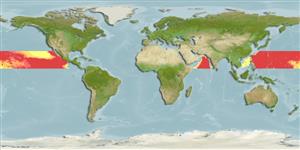Classification / Names
Common names | Synonyms | Catalog of Fishes(genus, species) | ITIS | CoL | WoRMS | Cloffa
Teleostei (teleosts) >
Scombriformes (Mackerels) >
Chiasmodontidae (Snaketooth fishes)
Etymology: Kali: Named after Kali, a Hindu goddess; falx: From the Latin falx, sickle; in a reference to the well developed sickle-shaped anterior most
tooth, a diagnostic characteristic for the species. A noun in apposition.
Eponymy: Kali, also known as Kālikā (‘the black one’) is a Hindu goddess, often depicted as having four arms. (Ref. 128868), visit book page.
Environment: milieu / climate zone / depth range / distribution range
Ecology
Marine; bathypelagic; depth range 1300 - 2870 m (Ref. 75596). Tropical; 29°N - 8°N
Atlantic, Indian and Pacific: Equatorial and tropical regions of the northern hemisphere: from a single locality in eastern Atlantic at 8° N; two localities in Indian at about 14° N; and Pacific Plate and Eastern Pacific, between 29° N and 10° N.
Size / Weight / Age
Maturity: Lm ? range ? - ? cm
Max length : 16.4 cm SL male/unsexed; (Ref. 75596)
Short description
Identification keys | Morphology | Morphometrics
Body elongate, laterally compressed. Greatest body depth at origin of first dorsal fin. Scales absent, except for lateral-line scales, embedded in skin. Kali falx is diagnosed from its congeners by a unique characteristic: first tooth in lateral remarkably enlarged, 17.2-20.5% in premaxillary length, sickle-shaped, projecting anteriorly (vs. first tooth in lateral series of premaxilla of same size or smaller than adjacent teeth in K. colubrina, K. kerberti, K. macrodon, K. macrura, and K. parri; fang-like, 15.2-16.4% in premaxillary length, slightly curved, not projecting anteriorly in K. indica).
Life cycle and mating behavior
Maturity | Reproduction | Spawning | Eggs | Fecundity | Larvae
Melo, M.R.S., 2008. The genus Kali Lloyd (Chiasmodontidae: Teleostei) with description of new two species, and the revalidation of K. kerberti Weber. Zootaxa 1747:1-33. (Ref. 75596)
IUCN Red List Status (Ref. 130435: Version 2024-1)
Threat to humans
Harmless
Human uses
Fisheries: of no interest
Tools
Special reports
Download XML
Internet sources
Estimates based on models
Phylogenetic diversity index (Ref.
82804): PD
50 = 0.5078 [Uniqueness, from 0.5 = low to 2.0 = high].
Bayesian length-weight: a=0.00389 (0.00180 - 0.00842), b=3.12 (2.94 - 3.30), in cm total length, based on all LWR estimates for this body shape (Ref.
93245).
Trophic level (Ref.
69278): 3.7 ±0.2 se; based on size and trophs of closest relatives
Fishing Vulnerability (Ref.
59153): Low vulnerability (10 of 100).
